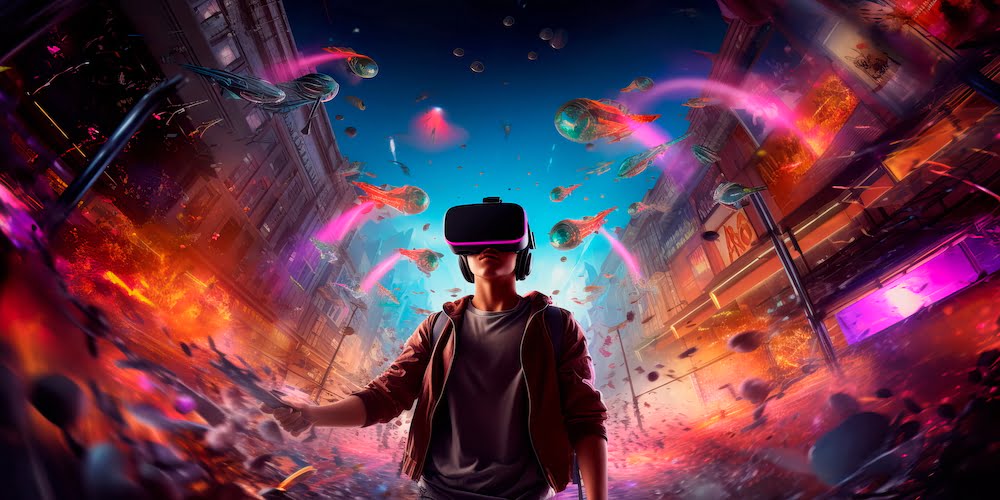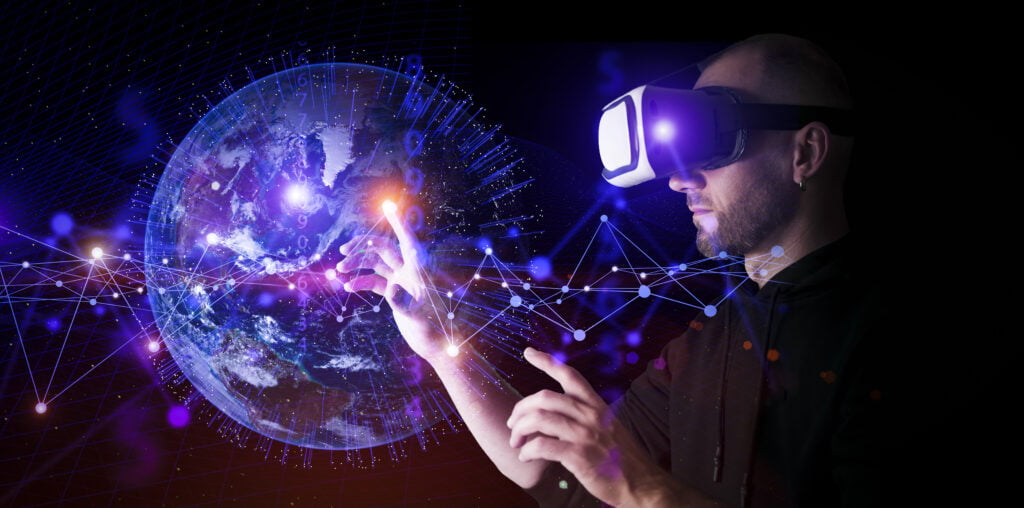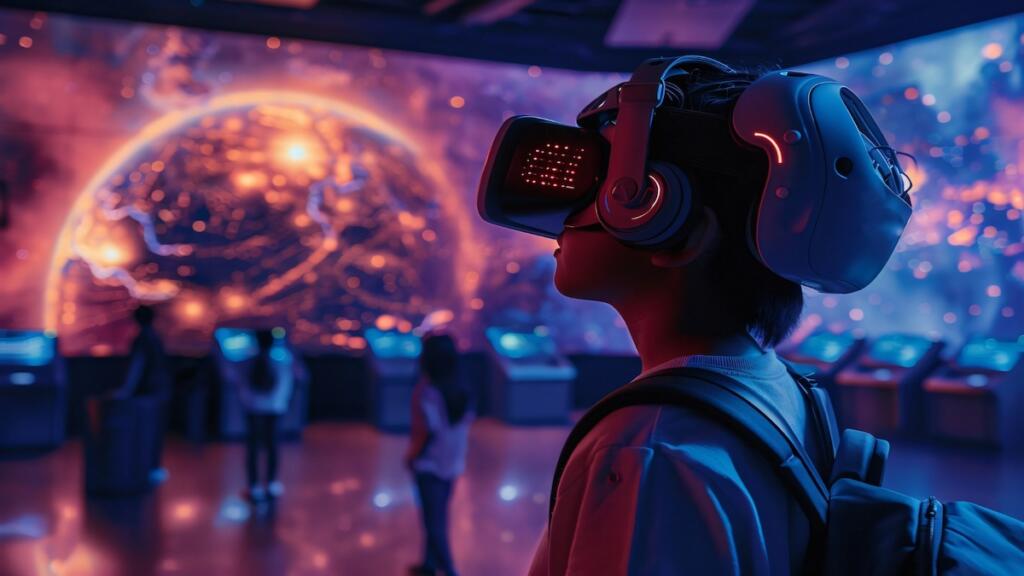The metaverse is more than just a digital playground; it is a loosely defined term referring to a virtual world where users interact through avatars, often in 3D, with a focus on social and economic connection. As an expansive digital ecosystem, the metaverse allows users to create, explore, and connect within interconnected virtual worlds. These worlds, often powered by advanced 3D graphics and real-time collaboration tools, provide a seamless blend of social and economic activities. At its core, the metaverse is a space where physical and digital realities converge, creating new possibilities for interaction and engagement.
Neal Stephenson’s Snow Crash introduced the metaverse as a futuristic escape from reality, capturing the imagination of readers with its vivid depiction of virtual worlds. The novel’s influence extended beyond literature, inspiring technologists and futurists to explore the potential of virtual environments. Following Snow Crash, other works like Ready Player One by Ernest Cline further popularized the concept. These narratives envisioned virtual spaces where individuals could immerse themselves in alternate realities, foreshadowing the metaverse’s eventual emergence as a technological frontier.

Evolution of Virtual Reality
Dawn of Virtual Reality
The journey of virtual reality began with pioneering efforts to create immersive experiences using new technology. Morton Heilig’s Sensorama, developed in 1962, was an early attempt to simulate real-world environments through sensory inputs. This invention laid the groundwork for future VR technologies by demonstrating the potential of multisensory immersion. Ivan Sutherland’s Sketchpad, created in 1963, further advanced the field by introducing interactive computer graphics. This innovation marked a significant milestone in the development of human-computer interaction and set the stage for modern VR systems.
World Wide Web and Its Impact on VR
The development of the World Wide Web by Tim Berners-Lee in the late 1980s revolutionized information sharing and connectivity. The Web’s open standards and protocols enabled global communication and collaboration, fostering the growth of VR technologies. As the internet evolved, it provided a platform for disseminating VR innovations and expanding their reach. The interconnected nature of the Web allowed VR to transition from niche experiments to mainstream applications, paving the way for the metaverse.
Metaverse Technology
How Metaverse Technology Works
The metaverse is built on a foundation of diverse technologies, including immersive computing, each contributing to its immersive and interactive nature. Virtual 3D environments provide the visual and spatial framework, while real-time collaboration software enables dynamic interactions. Blockchain technology ensures secure transactions and digital ownership, supporting decentralized finance within the metaverse. The seamless integration of these components creates a cohesive and engaging digital ecosystem, where users can explore, create, and connect.
Importance of Metaverse Technology for Businesses
Metaverse development offers significant opportunities for businesses, despite fluctuations in market hype. Virtual and augmented reality applications are gaining traction, enabling innovative solutions for marketing, training, and customer engagement. Companies are exploring how to leverage these technologies to enhance their operations and connect with consumers in new ways. The potential of the metaverse to create immersive brand experiences and streamline business processes makes it a valuable tool for forward-thinking organizations.

The Virtual World
Understanding the Concept of a Virtual World
The metaverse represents a convergence of physical and digital realities, facilitated by advanced technologies. Virtual worlds within the metaverse provide immersive virtual environments where users can interact, create, and explore. These environments are accessible through computers and enhanced by technologies such as VR, AR, and MR. The idea of blending physical and digital spaces has been explored for decades, but recent technological advancements have made it increasingly feasible and accessible.
Role of Virtual Reality Technology in Creating Immersive Experiences
Virtual reality technology plays a crucial role in enhancing virtual experiences within the metaverse. By providing immersive and interactive environments, VR allows users to engage with digital content in ways that were previously unimaginable. Applications of VR in the metaverse include digital twin technology, which creates virtual replicas of physical objects and processes for design and training purposes. In healthcare, VR can simulate medical procedures for training, allowing practitioners to practice in a risk-free environment.
Accessing the Metaverse
The Role of Virtual Reality Headsets in Accessing the Metaverse
Virtual reality headsets are essential tools for accessing the metaverse, offering immersive experiences that deeply engage users. These headsets provide a gateway to virtual worlds, enabling individual users to interact with digital content in a three-dimensional space. Augmented reality, which overlays digital information onto the physical world, is also vital for the metaverse’s growth. As companies compete for dominance, the metaverse is evolving into a collection of interconnected but distinct virtual worlds, each offering unique experiences.

Blockchain and AI in the Metaverse
Blockchain-Based Operations and Decentralized Autonomous Organizations (DAOs)
Blockchain technology is foundational to the metaverse, providing secure digital proof of ownership and enabling decentralized governance. Decentralized autonomous organizations (DAOs) leverage blockchain to facilitate transparent and democratic decision-making within virtual worlds. Blockchain also supports digital currencies, which are often used in the form of cryptocurrency, and enables the trading of assets as non-fungible tokens (NFTs). This ensures data validity and protects the diverse, valuable materials that constitute the metaverse. By decentralizing control, blockchain empowers users and fosters a more open and equitable digital ecosystem.
Intersection with Artificial Intelligence (AI) and Human-Computer Interface (HCI) Technology
Artificial intelligence (AI) enhances the metaverse by enabling advanced content analysis, speech processing, and computer vision. AI creates more sophisticated and responsive virtual environments, enhancing user experiences and interactions. Human-computer interface (HCI) technology is also crucial, allowing users to seamlessly interact with the virtual world through intuitive and natural inputs. The integration of AI and HCI technologies makes the metaverse more accessible and engaging, fostering deeper connections between users and digital content.
The Metaverse and Web 3.0
How the Metaverse Fits into Web 3.0
The terms “metaverse” and “Web 3.0” are often used interchangeably, but they represent distinct concepts. Web 3.0 aims to decentralize the internet by moving away from centralized servers and platforms controlled by a few large companies. The metaverse, on the other hand, focuses on creating immersive virtual environments where users can interact and engage. Both concepts share a vision of a more open, user-driven internet, but they differ in their implementation and focus.
Supporting Web 3.0 and Its Implications
Business executives are increasingly recognizing the potential impact of Web 3.0 and the metaverse on the economy and their operations. Advertising and marketing are seen as key entry points for utilizing the metaverse, offering innovative ways to engage with consumers. By leveraging Web 3.0 technologies, companies can create more personalized and interactive experiences, enhancing their brand presence and customer relationships.

Companies in the Metaverse
Apple, AWS, Epic Games, Google, Meta, Microsoft, and Nvidia
Several major companies are making significant strides in the metaverse, each contributing to its development in unique ways. Meta Platforms (previously Facebook) is planning on employing targeted advertising and collecting users’ personal information within their metaverse, raising concerns about privacy and spread of misinformation. Apple’s vision centers around its Apple Vision Pro headset, which aims to create immersive experiences for users. AWS supports various extended reality companies, including Meta, Magic Leap, and Nvidia, providing the infrastructure needed for metaverse applications. Epic Games, known for its Unreal Engine software and the popular game Fortnite, is partnering with The Walt Disney Company to develop its vision of the metaverse. These companies are at the forefront of metaverse innovation, shaping its future and expanding its possibilities.
Virtual Reality Technology in the Metaverse
How Virtual Reality Technology Enhances the Metaverse Experience
Virtual reality technology provides immersive and interactive environments within the metaverse, enhancing user experiences. Applications of VR in the metaverse range from digital twin technology to industrial design and healthcare. For instance, VR can be used for precise surgical training, allowing surgeons to practice specific procedures as often as needed. By creating realistic simulations, VR enables users to interact with digital content through digital avatars in meaningful and engaging ways.
Virtual Reality Technology Applications in the Metaverse
Virtual reality supports various metaverse use cases, demonstrating its versatility and potential. In industrial design, VR allows engineers to create and test digital prototypes, improving efficiency and reducing costs. In healthcare, VR can simulate medical procedures for training, enabling practitioners to practice in a risk-free environment. These applications highlight VR’s potential to transform multiple industries by providing realistic, interactive training and design environments.
The Future of Virtual Reality in the Metaverse
Utopian or Dystopian: How the Metaverse Will Affect the Future
Opinions on the metaverse’s future are divided. Some skeptics view it as merely an extension of existing digital experiences, while others see it as transformative. Despite the hype slowdown, most business leaders remain optimistic about the metaverse’s potential to revolutionize how we interact, work, and live. Meta’s platforms, including Horizon Worlds and Horizon Workrooms, are central to this vision, though they have faced criticism regarding user safety. The future of the metaverse will likely be shaped by technological advancements, user adoption, and regulatory developments.
How Businesses Should Prepare for the Metaverse
To create successful metaverse work environments, businesses must go beyond simply replicating existing office spaces in virtual spaces. They need to hire and train individuals who can think in 3D and apply VR to marketing and product development. This approach will help businesses leverage the full potential of the metaverse, creating immersive and engaging experiences for employees and customers.
Challenges and Limitations
Overcoming Technical and Social Challenges in the Metaverse
The metaverse faces several technical and social challenges, including cybersecurity and privacy concerns. The current lack of privacy regulations poses significant risks for businesses and users. Ensuring secure and private interactions in the metaverse will be crucial for its widespread adoption. Addressing these challenges requires collaboration between businesses, platform owners, and regulatory bodies to establish robust security and privacy safeguards.
Addressing Concerns and Limitations of the Metaverse
Businesses must develop viable data privacy policies and collaborate with metaverse platform owners and standards organizations to establish security and privacy safeguards. Consumers, too, need to understand the security and data privacy policies of the businesses and platforms they engage with in the metaverse. By addressing these concerns, businesses can build trust and foster a safe and secure metaverse environment.

Expanding the Vision: New Frontiers in the Metaverse
Integrating Augmented Reality (AR) in the Metaverse
Augmented reality (AR) plays a crucial role in bridging the gap between the physical and digital worlds within the metaverse. Unlike VR, which creates entirely immersive digital environments, AR overlays digital information onto the real world. This integration allows users to interact with digital content in their physical surroundings, enhancing their perception of reality. AR applications in the metaverse can range from interactive gaming and virtual tourism to educational tools and workplace training. By blending digital and physical experiences, AR enriches the metaverse, offering new dimensions of engagement and interaction.
The Role of Mixed Reality (MR) in Shaping the Metaverse
Mixed reality (MR) takes the integration of physical and digital worlds a step further by merging real and virtual environments to create new spaces where physical and digital objects coexist and interact in real-time. MR technologies, such as Microsoft’s HoloLens, allow users to interact with holograms and digital content while remaining aware of their physical surroundings. This capability is particularly valuable for applications in education, engineering, and healthcare, where users can visualize and manipulate digital information in a tangible context. MR’s potential to blend physical and virtual realities seamlessly positions it as a key technology in the evolution of the metaverse.
Digital Twins and the Metaverse
Digital twin technology, which involves creating virtual replicas of physical objects and systems, is revolutionizing various industries by providing detailed simulations for design, testing, and maintenance. In the context of the metaverse, digital twins enable users to interact with virtual representations of real-world objects and environments, facilitating better decision-making and problem-solving. For instance, in manufacturing, digital twins can simulate production processes, identify potential issues, and optimize operations. In urban planning, they can model city layouts and infrastructure to improve resource management and sustainability. The integration of digital twins in the metaverse enhances its utility, offering practical applications that bridge the virtual and physical worlds.
The Impact of 5G on the Metaverse
The rollout of 5G technology is set to significantly impact the development and adoption of the metaverse by providing faster, more reliable internet connectivity. 5G’s low latency and high bandwidth capabilities enable real-time interactions and seamless streaming of high-quality content, which are essential for immersive metaverse experiences. With 5G, users can enjoy smoother VR and AR applications, participate in large-scale virtual events, and collaborate in real-time with minimal lag. The enhanced connectivity provided by 5G will accelerate the growth of the metaverse, making it more accessible and enjoyable for users worldwide.
The Role of NFTs in the Metaverse
Non-fungible tokens (NFTs) are unique digital assets that represent ownership of a specific item or piece of content within the metaverse. NFTs are created and verified using blockchain technology, ensuring their authenticity and scarcity. In the metaverse, NFTs can represent a wide range of digital assets, including virtual real estate, artwork, collectibles, and even virtual clothing for avatars. By providing verifiable ownership of digital items, NFTs enable new forms of commerce and creativity within the metaverse. Users can buy, sell, and trade NFTs in virtual marketplaces, creating vibrant digital economies. The integration of NFTs in the metaverse fosters innovation and offers new opportunities for creators and consumers alike.
Social and Economic Implications of the Metaverse
The metaverse has the potential to reshape social interactions and economic activities by creating new platforms for communication, collaboration, and commerce, much like a video game creates immersive virtual experiences. In social contexts, the metaverse can facilitate more immersive and engaging interactions, allowing people to connect in virtual spaces regardless of physical distance. Virtual events, conferences, and social gatherings can bring together individuals from around the world, fostering a sense of community and belonging.
Economically, the metaverse offers new opportunities for businesses and entrepreneurs. Virtual marketplaces and digital economies enable the creation and exchange of goods and services, providing new revenue streams and business models. Companies can leverage the metaverse for marketing, customer engagement, and product development, reaching a global audience with innovative experiences. As the metaverse evolves, it will continue to influence social and economic dynamics, shaping the future of digital interaction and commerce.
Ethical and Regulatory Considerations
The rapid development of the metaverse raises important ethical and regulatory considerations that must be addressed to ensure a safe and inclusive digital environment. Issues such as data privacy, cybersecurity, and digital rights require careful attention and proactive measures. Businesses and platform owners must implement robust security protocols to protect user data and prevent malicious activities. Regulatory bodies need to establish clear guidelines and standards to govern the metaverse, ensuring transparency and accountability.
Additionally, ethical considerations around user behavior, content moderation, and digital inclusivity must be addressed to create a respectful and equitable metaverse. Ensuring that the metaverse is accessible to individuals with diverse backgrounds and abilities is crucial for fostering an inclusive digital ecosystem. By addressing these ethical and regulatory challenges, stakeholders can build a metaverse that is safe, secure, and beneficial for all users.
Conclusion
Recap of the Metaverse and Its Significance
The metaverse is a dynamic digital ecosystem that integrates virtual reality, augmented reality, blockchain, and AI technologies to create immersive and interactive environments. It has the potential to transform how we interact, work, and live by offering new dimensions of engagement and connection. As technology continues to evolve, the metaverse will likely become an integral part of our digital landscape, shaping the future of social and economic interactions.
Final Thoughts on the Future of Virtual Reality and the Metaverse
The metaverse is not just a futuristic concept; it is a tangible reality that is evolving and expanding. Its impact will depend on how technologies are integrated and adopted, as well as how ethical and regulatory challenges are addressed. The future of the metaverse promises exciting opportunities and challenges, shaping the next era of digital interaction. Businesses, technologists, and users must work together to navigate these opportunities and challenges, ensuring a safe, secure, and engaging metaverse experience for all. As we continue to explore and build the metaverse, we are paving the way for a new era of digital innovation and interaction, where the boundaries between physical and virtual realities are increasingly blurred.




